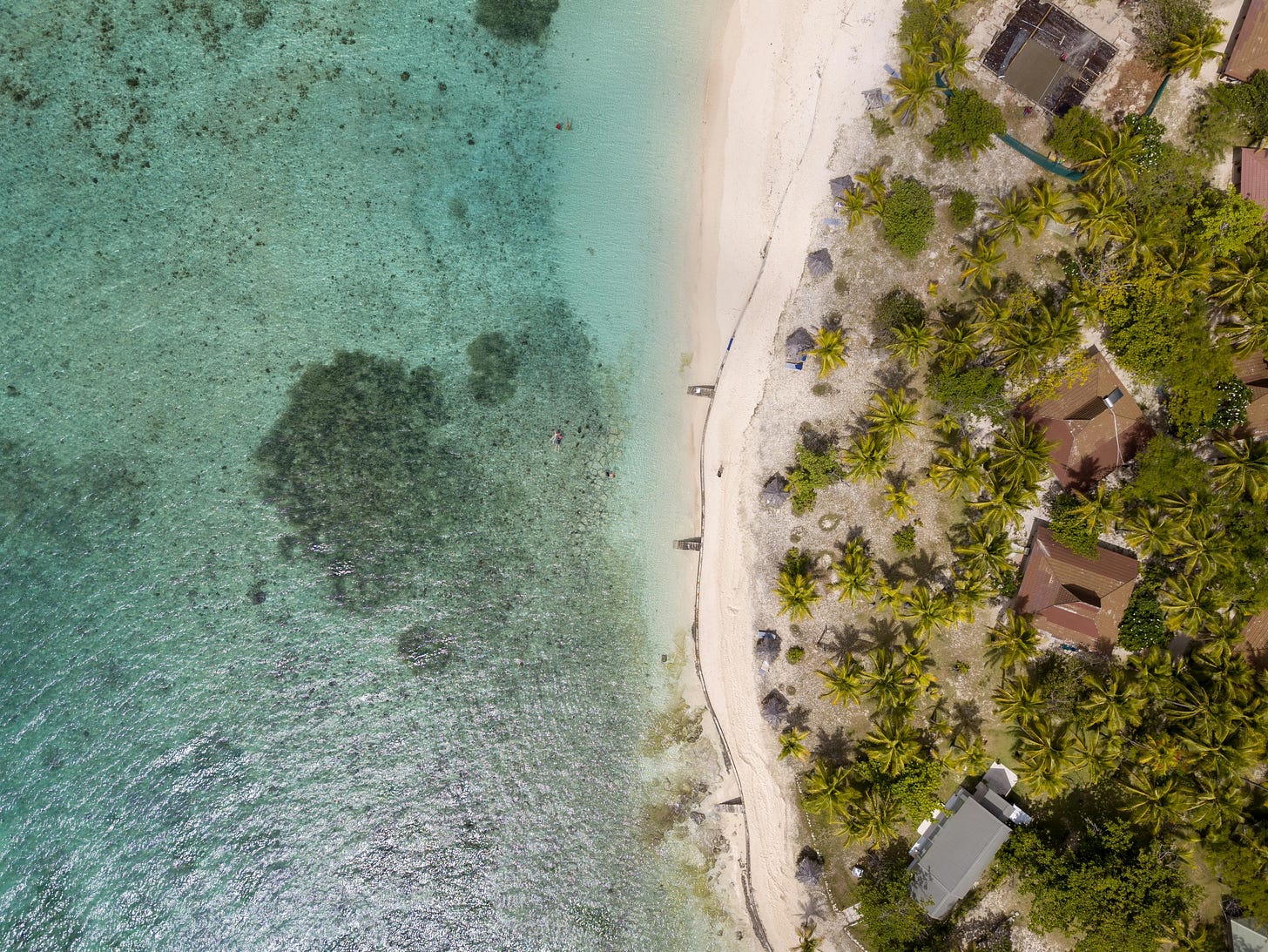Can I pull you for a chat to talk about reality TV’s environmental impact in Fiji?
"Love Island" and "Survivor" are both filmed on the climate-vulnerable islands of Fiji.
My Instagram feed has been a mix of “Love Island USA” commentary and news about Trump’s Big Beautiful Bill. It's felt dystopian. On the one hand, I loved the mental break from this rough news cycle, but on the other, it felt like more people were rallying to get Huda to “crash out” than care about the reality we’re living in. If only political uprisings were as simple as downloading an app and voting for your favorite Islander, maybe we’d see more mass mobilization.
“Love Island USA” is the hottest TV show in the U.S. right now, with record-breaking app users, millions of daily viewers, and hundreds of watch parties taking place in bars across the country. Amaya Papaya stole our hearts during Season 7 of “Love Island USA,” but I want to shift the conversation toward reality TV’s impact on the local environment.
Both “Love Island USA” and “Survivor” are filmed on the beautiful islands of Fiji. This location has become a top choice for production companies due to its consistent weather patterns (sunny and warm temperatures) and beautiful scenic views, which seem to be a plus for a survival show or a romantic love story.
With Fiji becoming a top choice for reality TV production, what are the environmental impacts of our favorite shows? There are several ways to approach this question, but there’s no clear way to quantify it due to limited data and resources on the direct environmental impact. Still, we can get a good overview of the environmental impact of hosting these shows, from energy usage to waste management.
Environmental Damages
Until Season 33, “Survivor” was known to change locations. Now, each new season is filmed on one of the hundreds of islands in Fiji. According to very reliable sources on Reddit, CBS’s “Survivor” was banned from the Cook Islands after leaving behind a mess from its challenges and equipment. I did not see an article specifically stating this, though, based on the waste left behind in Fiji from the show, it would not be surprising.
“Survivor” contestants are definitely not a part of the “Leave No Trace” initiatives that granola campers and backpackers typically follow. “Leave No Trace” is a general rule that backpackers typically follow to preserve the natural ecosystem they explore, minimizing interruptions during their time in nature. They try to leave no trace of their presence by not feeding wildlife, picking up their waste, and more.
With elaborate challenges, branch-cutting for shelter, and contestants living in one designated area for weeks, the show clearly doesn’t follow “Leave No Trace” principles. The show’s elongated stay in the middle of Fiji’s tropical forest can affect the local wildlife, native plants, and overall ecosystem if the contestants interrupt the natural patterns of the area.
Fiji’s tourism board welcomes these productions and is open to hosting more shows, according to a NYT article. I am sure that the financial compensation and international recognition that would bring more tourism (and, consequently, more money) to the country are significant factors in the warm welcome. However, climate change might be contributing to the extended hot periods that these productions often seek for their TV show (more on this later).
Energy Use
Unlike “Survivor,” where the contestants are camping for weeks, “Love Island” contestants live in a massive villa during their six-week stay. LI’s six weeks of constant 24/7 air conditioning and 80 hidden cameras that are rolling all day have a massive energy impact. According to the International Energy Agency, cooling accounts for approximately 10% of global electricity demand. As global temperatures rise, air conditioners will run for longer periods, fueling a cycle of greenhouse gas emissions and growing temperatures.
Almost 60% of Fiji’s energy is derived from hydropower, a renewable energy source, but some parts of the islands still rely on imported fossil fuels and biomass. Given that Fiji is known for its sunny weather, there has been mention of the missed opportunity to use solar panels.
Love Fast Fashion Island
Day and night, “Love Island” contestants are dressed to the nines in beachwear, with every outfit dissected piece by piece on social media. Unlike last year’s "People’s Princess," Leah Kateb, who regularly wore vintage pieces and high-end luxury items, “Love Island” contestants usually wear fast fashion. The typical wardrobe of the Islanders consists of Fashion Nova, Shein, Romwe, Princess Polly, and several other fast fashion powerhouses.
Notably, the “Love Island” contestant-to-fast-fashion sponsorship pipeline has been growing since the show first gained popularity in the UK. Companies will form quick and timely partnerships that capitalize on the peak of the contestant's fame right after the show. The paid posts promote even more consumerism, as viewers want to dress like the gorgeous women on their TVs, and now these brands will offer the new influencers a discount code for their followers.
Single-Use Challenges
Both “Love Island” and “Survivor” are known for their elaborate challenges. While “Survivor’s” challenges usually have a reward like food or immunity, “Love Island’s” games are mainly to incentivize contestants to make out with one another. The set equipment and single-use costumes (in LI’s case) are a large part of the shows, and it seems like each season has new and bigger challenges.
A Redditor shared photos of “Survivor” challenge equipment lying outside on a beach in Fiji, and they mentioned that the equipment is usually either burned or reused. I could not find anything about the equipment being burned outside of the post. Still, it does not seem far from reality since burning the items can be a cheap way to manage waste. However, the cheap shortcut has a massive environmental impact. Burning trash can release toxic chemicals into the air, water, and soil, especially when plastics and other materials like treated wood are involved.
The “LI” challenge sets are colorful and decorative, which seamlessly match the villa’s aesthetics. But there is little overlap between the challenges. This means that many of these challenges require new costumes for all the contestants (because how can a show survive without single-use clothing items to match the aesthetic), as well as decor, designs, and much more.
If these TV sets were reused, stored properly, and didn’t rely on single-use costumes, I doubt the competition or entertainment factor would suffer.
“Love Island” and “Survivor” are not alone in creating these energy-sucking and elaborate single-use sets in a tropical place for the sake of entertainment. It feels like every reality show takes place in a beachside villa, is backed by fast fashion sponsors, and generates waste all in the name of entertainment. And yes, I’ll still occasionally tune in—shamefully.
No place on Earth is immune to the effects of climate change. Coastal communities, such as those in Fiji, have been at the center of climate change conversations due to the potential mass displacement of their residents. Rising sea levels in coastal communities have caused frequent flooding, forcing residents to abandon their homes and become climate refugees. A study surveying 70 Indigenous and other traditional Fijians revealed that climate change is affecting their mental health. This is because extreme weather events like prolonged heat, flooding, etc., can cause forced relocation, leaving behind traditions and culture that the Indigenous people had with the land.
While a couple of TV shows are not directly causing rising temperatures or climate anxiety, as viewers, it would be meaningful for the shows to incorporate conservation efforts and, at the very least, acknowledge climate change. The erasure and dismissal of climate change in the communities these shows profit from shouldn’t go unnoticed.
Thank you so much for reading my takes, research, and thoughts on these reality shows. I loved writing about this with an environmental and social lens.
It would mean so much to me if you could comment your takes and ideas, share this post, and subscribe. Thank you so much!!







